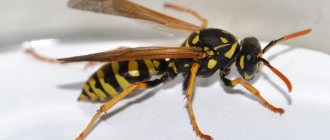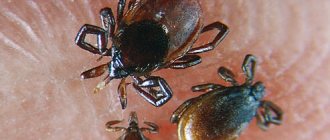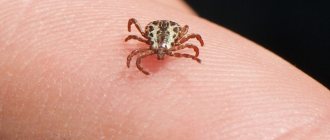The importance of ticks in nature and human life
There is no place on Earth where ticks are not found.
These arachnid pests live in every part of the globe. The variety of ticks is very huge. To date, about 25 thousand species have been identified. Each species has its own structure, its own way of life, color, size, among them there are mites that harm plants and human health, there are also blood-sucking specimens and simply parasites. Still, we cannot discount the fact that in nature ticks are quite important. The greatest harm to human health is caused by ixodid ticks - they feed on human blood and carry various diseases and viruses with their bite. From an ecosystem point of view, ixodid pests are simply irreplaceable in nature; they act as a regulator of natural selection. How it works? The tick bites a passion that is weaker than itself, and she naturally dies. The stronger insect eats the killed passion and thereby develops immunity. In this regard, nature maintains a numerical balance of individuals.
Which ticks harm humans and animals?
There are several types of ticks that harm humans and animals. Some of them attack humans or animals outside the home, and some live in human habitation. What unites them is that they all love blood. The danger of these ticks is that they carry diseases that can threaten human health and even life. Such diseases include encephalitis, borreliosis, ehrlichiosis and many others. The most common types of such ticks are:
- ixodid tick - bites both humans and their pets and is a famous carrier of diseases, has a flat body measuring 0.5–0.7 cm and a dark red color with a black head,
- argas tick - lives in caves, burrows, crevices of houses, its size ranges from 3 mm to 3 cm, the bites of this tick are very painful,
- gamas mite - parasitizes rodents, birds and is especially common in rural areas, but can also settle in city apartments, especially on the first and last floors, its size is from 0.2 to 4 mm,
- subcutaneous mite - causes the disease demodicosis, a person develops a red itchy rash in the area of the face and scalp,
- scabies mite - lives under human skin and gnaws through a whole system of passages there, causing acariasis (scabies), the infected person develops red rashes on the skin in the groin area, between the fingers, armpits,
- ear mites are a nightmare for cats and dogs, they grow in the ears and cause severe itching, unfortunate animals rip their mite-infested ears into blood,
- bed mite - lives in a person’s bed, feeds on the skin and causes itching, unlike a dust mite, bites a person, although it does not drink blood, like, for example, the ixodid tick.
Video: which ticks harm humans and animals
Benefits from ticks
Even bad associations between people and pests do not negate the fact that arachnids actually bring benefits to the ecosystem.
- Agriculture.
Everyone knows that there can be damage that ticks can cause to agriculture, but there are still benefits from them.
Most mites are small saprophages; they process organic matter, which significantly increases soil fertility, which is an important unit for agriculture. A predatory mite can destroy other individuals that cause more damage to the crop, for example, spider mites. It can destroy your crop almost completely within a season. Another benefit of mites is that they can clean flowers and plants that have been infected with fungi from them, which gives them strength and recovery for further development. Interesting fact. Some types of mites are used to make different types of cheese. - Medicine.
There is also a particular interest in mites in this industry. Enzymes contained in the saliva of arachnids (anticoagulants) actively work to reduce the intensity of the blood clotting process. Also, doctors are interested in tick antigens, which work to form antibodies and other protective reactions in the victim’s body.
In the ecosystem, ticks are also the connecting link of the entire chain. Frogs and various birds feed on ixodid ticks.
What harm do arachnid pests cause?
As mentioned earlier, the most dangerous tick is the ixodid tick. There is also the taiga (encephalitis) tick, which is also a carrier of encephalitis and other dangerous diseases that can cause serious health problems. There are confirmed cases of deaths from bites of these particular types of ticks. These types of arachnids feed only on blood. When bitten, the virus and the causative agent of the disease enter the human body along with the saliva of the tick. In addition to these two types of dangerous mites, the following types can be contagious: subcutaneous mites or scabies. There will be no lethal outcome from their bite, but diseases such as scabies or dermatitis are guaranteed.
Types of ticks
In general, harm to humans can be caused not only by parasitic ticks, but also by completely harmless ticks. Their sizes are so small that they can be anywhere (in the garden, in the house, in bed, in things, in clothes, in food, and so on). Flour mite
- eats cereals and its ability is that it spoils a huge amount of food.
Dust pest
– feeds on epidermal debris and dust.
If you are "kissed" by a dust mite, you may develop asthma (especially those with allergies). Ear mites
– this species harms pets.
They feel a huge itch in the area of the ears and are able to scratch them until they bleed. Spider mites
are a species that all gardeners and indoor plant lovers fear.
It is capable of destroying all seedlings, so it is necessary to take action in time. The most distinguished group of mites is the oribati mites.
They can be found in forest soils.
They feed on rot (plant debris). This type of arachnid can harm livestock; they are carriers of tapeworm. Chicken mite
- they feed on the blood of birds and chickens. They go hunting mainly in the dark. Birds often die from lack of blood.
Mites in food, dust and on plants
Now let's talk about ticks, which do not feed on blood, but can also cause damage.
Flour mite
This pest feeds on flour and cereals and can spoil a lot of food. The size of the insect is only 0.3–0.7 mm. You can tell that there are flour mites in your products by the mint-like smell and sweetish taste of the product.
Dust mite
This arachnid lives in human homes and feeds on dust and dead skin particles. It is because of this that allergy sufferers and asthmatics suffer. The size of these pests is only 0.5–0.1 mm. You can determine that a dust mite is in your home only by a sudden exacerbation of asthma or the appearance of an allergy.
Spider mite
This small creature parasitizes plants. Spider mites are a nuisance to gardeners and flower lovers and can destroy plants. There are several types of these parasites. Here are the most common of them:
- red spider mite - this pest prefers flowers and is found on roses, callas, orchids,
- cyclamen mite - the favorite victim of this arachnid is, of course, cyclamens,
- wide spider mite - loves cacti, citruses and oleander,
- bulb mite - affects the bulbs of tulips, hyacinths and other flowers underground, gnawing out its core, which leads to the death of the plant,
- Atlantic and Pacific ticks - live in warm regions, feeding on the leaves of citrus fruits and palm trees,
- flat orange mite (flat mite) - mainly violets suffer from it.
Video: which mites harm plants
What do forest ticks eat?
They feed on the blood of various animals, including human blood.
Everyone knows that ticks cannot jump to a height of more than 1 meter. Therefore, when they attack a victim, they try to get to the soft tissues and climb higher. Females are more voracious than males. The female can drink blood without stopping for about 7 days in a row, when three days is enough for the male.
The tick bite itself is not felt, since when they pierce the skin they inject special saliva that blocks the pain and thus the victim does not feel the bite and may not immediately recognize that the tick is on her.
How does a tick sense its prey? They have a very developed sense of smell. If the victim stops for a few minutes in the forest. The tick will immediately smell it.
How to protect yourself from tick bites
If you go to the forest to pick mushrooms or just relax, it is important to understand that you can encounter ticks there. How to protect yourself from pests?
- If you are camping outdoors, be sure to close your tents well. Before you go to bed, check everything thoroughly for insects.
- Pay attention to clothes and shoes. It is more difficult to notice a tick on dark clothing than on light-colored clothing; try to wear light-colored clothing. Also pay attention to the fact that there are elastic bands on the cuffs, jacket and pants. It is best to have a hood on your head (this way the tick will fall to the ground, and from the hat there is a high probability of rolling onto your neck).
- Relax in nature during the day when it is light.
- Be careful when lifting branches and stones.
- Cover all open areas on your body.
If you are still bitten by a tick, then it is important to know exactly how to pull it out so as not to cause disastrous consequences. It is important to know that at the very moment the tick bites, it sticks its proboscis, which has many small spines, into your skin. Therefore, if you pull your proboscis along the axis, there is a high probability that the “spines” will dig into your skin even tighter. This can lead to the fact that the proboscis may remain forever in your skin, and you can simply separate and destroy the tick body itself. To prevent this from happening, you need to remove the tick from under your skin using circular movements. It turns out that the “pinches” on the proboscis will curl along the axis and the body will not be able to tear itself away from the proboscis.
Interesting facts about ticks:
- Ticks live wherever there is grass. Therefore, even on your summer cottage on the lawn you can find ticks.
- After a tick lands on a person’s body, it does not immediately attach itself, but searches for softer tissue. In total, the entire process can take about 15 minutes.
- Do not burn ticks or poison them with vegetable oil. The fact is that there is a myth that vegetable oil and cauterization will cause the tick to crawl out from under the skin - this is not true. The fact is that the vegetable oil will not suffocate the tick and if you burn it, it will not come back out. On the contrary, it can cause more active penetration into the skin, which will worsen the situation.
- A tick can infect several diseases at once.
- The drier the summer, the fewer ticks. Ticks love moisture, so their hunting season is autumn - spring.
Educational program. How dangerous are ticks?
Author:
Skrypnik Ksenia
3 minutes
1554
How to remove ticks correctly, is there emergency vaccination, and other answers to important questions about ticks.
What kind of ticks are we talking about?
There are more than 40 thousand species of ticks in the world. Despite such diversity, not all of them are dangerous, but only some of them. Ixodid ticks are carriers of dangerous diseases - they lead a parasitic life and feed on the blood of animals. Russia is inhabited by the taiga tick, which is found mainly in the Asian part of the country, and the European forest tick, which predominates in the European part.
Female ticks are much more dangerous than males - they can stick and feed on blood for a whole week. However, males, nymphs, and tick larvae pose a danger.
Where do ticks live?
Contrary to popular belief, in order to become infected with tick-borne encephalitis or another disease for which they may be a carrier, it is not at all necessary to go to the taiga (although the likelihood of infection there is much higher). Ticks are found both in city parks and in summer cottages. They prefer well-moistened places overgrown with grass.
Many people believe that ticks wait for their prey and then jump on top of it. However, more often the tick sits on the top of a blade of grass or a low bush and simply grabs onto someone who passes by. It begins to climb from the bottom up - the tick can reach the head of an adult in 15 minutes.
How dangerous is a tick bite? If I am bitten by a tick, will I get sick?
Ticks can transmit various diseases. They can cause not only tick-borne encephalitis and borreliosis, which many have heard of, but also tick-borne relapsing fever, ehrlichiosis, anaplasmosis and other diseases. The likelihood of infection depends on the region where the tick lives.
The virus enters the bloodstream immediately after the bite, but the first symptoms of the disease may not appear immediately, but after several days or even weeks. It is not at all necessary that you will get sick after being bitten. Firstly, not all ticks are infected, and secondly, only about 5% of those bitten by infected ticks become ill.
Diseases caused by ticks, in rare cases, can be asymptomatic, but more often a febrile state occurs: the temperature rises, headaches, increased fatigue, and joint pain appear. In addition, paralysis, problems with hearing and vision may develop. Many residual effects can persist for several years after the illness.
What should I do if I find a tick on myself?
The tick must be removed as soon as possible - the longer it stays on the body and feeds on blood, the greater the likelihood of infection. It is best to go to the emergency room, where a specialist will remove the tick.
If this is not possible, then you will have to act independently. You need to grab the tick as close to the skin as possible - you can try to pull it out with your fingers, tweezers or thread. It is worth trying to pull out the entire tick. If the arthropod's head remains inside the skin, do not panic, it can be removed like an ordinary splinter.
You should not smear the tick with oil or anything else - this will make it suck blood more intensely and only increase the likelihood of infection. But it is better to disinfect the wound left after a bite.
What to do with the tick itself?
The tick must be placed in a jar, in which you should place a damp cotton wool or gauze, after which you must take it for analysis - where exactly, you can be told at the emergency room or the ambulance service by calling 03. List of laboratories and services involved in the analysis of ticks and Emergency immunoprophylaxis can be found here.
10 days after a tick bite, it is necessary to donate blood to detect tick-borne encephalitis using the PCR method, after 2 weeks - to undergo a test to detect IgM antibodies to the tick-borne encephalitis virus, and another week - to detect IgM antibodies to borreliosis. Remember that ticks can also cause mixed infections; your doctor will prescribe tests to detect them.
How can you protect yourself for the future?
The most effective way to prevent tick-borne encephalitis is vaccination. You can get vaccinated at any time of the year, but you need to remember that vaccination consists of several stages - at least two weeks should pass between the second vaccination and a possible encounter with a tick. The standard vaccination regimen takes at least 45 days, and the emergency one – at least 21. The exact timing depends on the vaccine chosen.
If you are not vaccinated, but emergency vaccination is necessary (or if you have already been bitten by a tick), immunization with a specific immunoglobulin against tick-borne encephalitis is prescribed.
And if there is no opportunity to get vaccinated, why not go to the forest or go to the country?
However, you can try to minimize the risk of being bitten. When going into the forest, you should tuck your pants into your shoes and your T-shirt or shirt into your pants. You need to tie a scarf around your neck and put a hood on your head. You need to examine yourself and your comrades at least once every 15-20 minutes.
You can also use repellents - there are products that need to be applied to open areas of the body, and there are acaricide sprays based on permethrin and alphamethrin, sprayed directly onto clothing. The effect of this treatment lasts for a week.
However, we must remember that neither special clothing, nor anti-tick agents, nor even vaccination can provide 100% protection.











